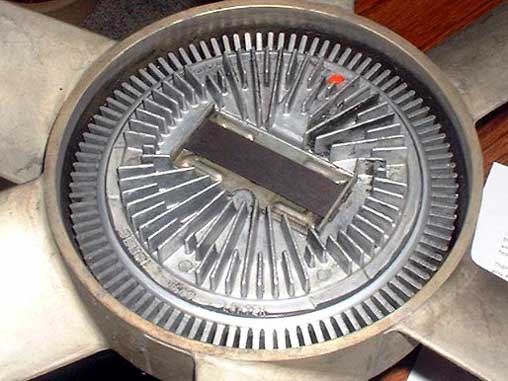

Viscous Fan Coupling

Image courtesy of John Krawczyk
There is no specific testing data available as far as I am aware.
The following is what I did with my car. If you are mechanically minded and have the tools you can follow this procedure
if you like but as always, it is your choice. Your model may vary.
Simple test #1
- Does your car run at a satisfactory temperature whilst moving?
- Does your car's temp climb whilst at low speed or sitting in traffic and then come back down once you are
moving at a reasonable pace?
If you answer yes to both questions you most likely have an air flow problem which would most likely be the
Viscous Fan Coupling (VFC) If your car is running at high temps whilst moving it is likely to be a liquid flow problem
of some sort.
Simple test phase 2 - Fabricate a VFC locking plate.
If you think it is the VFC you can temporarily test it by 'locking it up' as follows.
THIS MUST BE A TEMPORARY MEASURE ONLY AS THE FAN IS NOT DESIGNED TO BE RUN AS A FIXED UNIT!
The purpose of this test is to increase the airflow over the radiator. If this "fixes" the temperature problem you know
it is the VFC. Then you can take the appropriate action to make the correct repair.
Viscous Fan Coupling Locking Plate
The diagram below shows the plate I fabricated to lock the VFC in place in order to determine if it is not spinning fast
enough to provide enough cooling over the radiator.
DISCLAIMER: - This locking plate 'tool' is NOT Porsche approved and must be used at your own discretion. I used the tool Your Methods May Vary.
This diagram is a fabrication guide only.

- On the VFC drive shaft you will see two flat slots to fit a 19mm spanner.
- Cut and file a slot in the side of a strip of (6mm thick) aluminium so that it is a snug fit over the spanner slots on the shaft.
- Drill two holes in the aluminium plate to bolt through to the VFC. Bolt the locking plate over the shaft using the existing bolts that hold the fan to the coupling.
Once the VFC is locked into position the fan will spin at engine speed . DO NOT GET YOUR FINGERS IN THE WAY OR YOU WILL LOSE THEM - or any other appendage for that matter!
USE ALL SAFETY PRECAUTIONS AS NECESSARY
Take the car for a drive in heavy stop start traffic. If the engine now runs at the correct temperature you need to
either replace or refill the VFC. Replacement will cost you around $600 for a new VFC plus fitting or around $250 for a
used unit (probably with the same problem - why bother?). Refilling will cost about $25 for the silicone oil from Toyota.
Part number is 08816-10001 from the local Toyota dealer (thanks Pinky).
You will also need a flameless heat gun and some RTV sealant. The refill works well - I recently did it with my car.
Including buying a heat gun and the RTV is cost me less than $70 all up.
There are two refill procedures that I found on the web:
http://www.nichols.nu/tip482.htm
http://members.rennlist.com/blueshark/page11.html
Remember - your methods may vary.
Hope this helps.
Regards Rick H., '86 Meteor Metallic Auto - Melbourne


